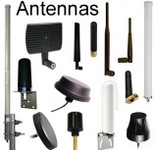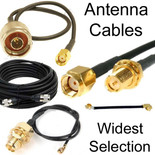Antennas, Antenna Cables, Wireless Products: Technical Articles
U.FL & MHF4 Antenna Cables: Thickness of Cable & other Key Considerations
Table of Contents
Coax Types for MHF4 and U.FL Cables
The four coaxial cable options for U.FL cables: 1.13mm, 1.32mm, 1.37, and RG174. RG178 is a less-common fifth option.
- All four have a black jacket.
- All four are RoHS and REACH compliant.
- All four are impedance-matched to 50 Ohm antennas and antenna cables, and compatible with frequency bands from 0GHz to 11GHz - therefore compatible with almost all typical wireless applications.
- MHF4 cables can only be made with 1.13mm coax, because of the tiny size of MHF4 connectors.
1.13mm mini-coaxial cable
This is a very thin and flexible cable, with a black jacket. When connecting U.FL connector to a jack on a miniPCI card or board, sometimes the tight space requires the use of 1.13mm cable, because it is very thin and flexible: It is not always necessary to use 1.13mm cable, but on occasion it is necessary to use 1.13mm cable, to prevent the U.FL connector from popping off the U.FL jack.
1.32mm mini-coaxial cable
Is a double shielded coax with much lower signal loss than 1.13mm, while still being very flexible and thin: 1.32mm diameter.
RG-174-equivalent cable-type
Is the thickest and best-shielded coax that we can use with U.FL cables. RG174 has a black jacket.
- This is the thickest and lowest-loss coax option for U.FL, but is not an option for MHF4 or W.FL. RG-174 cable is lower-loss than 1.13, while still very flexible/easily bendable coax with black jacket. The braided shielding is a major factor in the higher quality of this cable, which translates into lower loss/better performance.
- Sometimes a tight space requires thinner coax: (1.13mm or 1.32mm mini-coaxial cable): When connecting U.FL connector to a jack on a miniPCI card or board, often the tight space requires the use of thinner coax (1.13mm mini-coaxial cable), because it is very thin and flexible (diameter is 1.13mm). This very thin cable is sometimes needed in tight spaces inside of enclosures, so that the U.FL connector will snap down on the jack without popping off.
- Since RG-174 has lower signal loss: If this cable works for you without the U.FL connectors popping off the jacks, then this thicker coax is the better solution. You can use a hot glue gun to secure the jack onto the PCB, in which case, of course, the thicker cable will not be a problem: This is the best way.
For short U.FL cables, we use 1.13mm coax as the default, and for longer U.FL cables we use RG174 by default. We can make special orders of U.FL cables with RG-174 (for lower signal loss), 1.32 or 1.13mm cable, for better flexibility.
For applications requiring a U.FL connection to devices with antenna jacks using SMA Connector or RP-SMA Connector, antenna cable adapters are a convenient solution. Cables like RP-SMA to U.FL or SMA to U.FL provide compatibility between different connector types.
MHF4 cables, and W.FL cables cables can only be made with the very thin coax 1.13mm. MHF4 is not compatible with LMR100 and RG178.
1.13, 132, and RG174 coaxial cables: All three have a central, plastic insulated wire to conduct the RF signal, further surrounded by a braided mesh, shielding the conducting wire from electromagnetic interference. This conducting shield is covered by an outer insulating layer. The design provides extremely efficient data transmission and where appropriately connected to an antenna the RF signal can be transmitted with minimal signal loss.
1.13, 132, and RG174 coaxial cables range of frequency band compatibility (from 0 to 18GHz) and 50 Ohms impedance matching, makes them suitable and compliant for all the following applications:
- All WiFi standards: 2.4GHz and 5GHz applications: 802.11AC, 802.11N, 802.11G, 802.11B, 802.11A
- Cellular Wireless LTE / 4G, GSM / 3GWiMax: Data and voice applications
- IoT wireless & Bluetooth, ZigBee, RFID, LoRa, LTE-m, NB-IoT.

Attenuation of 1.13 Coax for Micro-connectors
| Attenuations ( Nominal ) | |
| Frequency ( MHz ) | Attenuation ( dB / 100m ) |
| 1000 | 230 |
| 2000 | 310 |
| 3000 | 390 |
| 4000 | 460 |
| 5000 | 510 |
| 6000 | 580 |
See list of all of our articles about U.FL cables and connectors.
Micro-connectors
 U.FL to SMA Cable diagram
U.FL to SMA Cable diagram
If there is a U.FL jack on your PCB, it is a U.FL male.
Conclusion
U.FL and MHF4 cables use ultra-thin coaxial types to balance flexibility, space constraints, and signal performance. The most common options—1.13mm, 1.32mm, 1.37mm, and RG174—are all 50 Ohm, RoHS- and REACH-compliant, and suitable for frequencies up to 11 GHz. MHF4 cables can only use 1.13mm coax due to their tiny connector size, while U.FL cables offer more versatility. For tight spaces, 1.13mm is preferred; for lower signal loss, RG174 is the best choice. Each cable type ensures efficient RF signal transmission across Wi-Fi, cellular, and IoT applications, with adapter options providing compatibility between U.FL, SMA, and RP-SMA connectors.
FAQs
What are the main coaxial cable types used with U.FL cables?
The primary coax options for U.FL cables are 1.13mm, 1.32mm, 1.37mm, and RG174, with RG178 being a less common fifth option. All are 50 Ohm, RoHS- and REACH-compliant, and suitable for frequencies up to 11 GHz.
Which coax type is used for MHF4 cables?
MHF4 cables can only be made with 1.13mm coax due to the extremely small connector size. Thicker cables like RG174 or RG178 are not compatible with MHF4 or W.FL connectors.
When should I choose 1.13mm coax instead of RG174?
Use 1.13mm coax in tight spaces—such as inside enclosures or near miniPCI boards—where flexibility is crucial. Choose RG174 for longer cables or when minimizing signal loss is a priority, as it offers better shielding and lower attenuation.
What applications are these coax cables suitable for?
These cables support all Wi-Fi (2.4GHz and 5GHz) standards, cellular (LTE/4G/3G), and IoT technologies including Bluetooth, ZigBee, RFID, LoRa, LTE-M, and NB-IoT—making them ideal for most wireless communication systems.
How can I connect U.FL cables to SMA or RP-SMA connectors?
Use adapter cables such as U.FL to SMA or U.FL to RP-SMA, which bridge devices that use different connector types while maintaining impedance matching and signal integrity.








